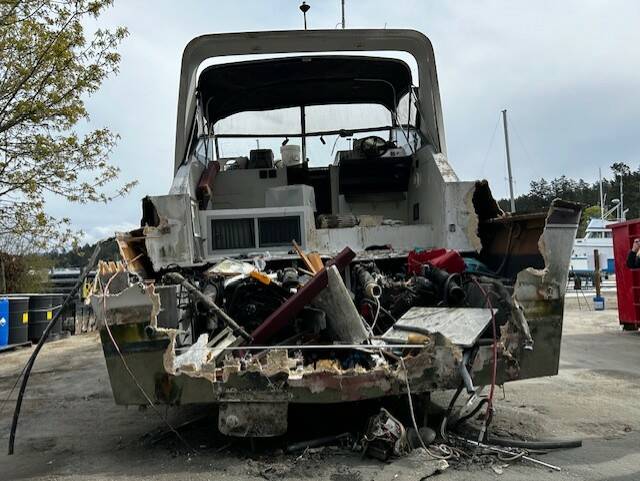The masts clanged slightly on the handful of boats docked and waiting for deconstruction. It was clear from the moss and lichen covering the windows and cabin that these vessels had not been at sea in a long time.
A mixed crowd, from Marine Resource Committee members to Port of Friday Harbor staff, Department of Natural Resources and other interested parties gathered on April 4 to look at the Derelict Vessel Project firsthand.
“It saves the state more money to remove them before they become derelict or abandoned. If a boat sinks or runs aground it is going to cost the state two or three times more. So, the program started up and it has been a good success,” Tammy Robbins, Department of Natural Resources Vessel Turn-in Coordinator, explained. These boats are voluntarily turned in by the owners, and the state takes care of the rest. “We had a $200,000 biennium budget when we first started and that didn’t last very long.”
The following year the budget increased, and the program was able to grow taking even more boats out of the water. There have been three coordinated events in the state. San Juan County’s was the third and by far the most successful. DNR partnered with the County, the MRC, and the Port of Friday Harbor for the turn-in event. The Port of Friday Harbor capped the number at 15, unsure of the response. Not only was that cap reached, but more are waiting to be turned in.
The boats came from all over the county, Kari Koski, San Juan County Environmental Stewardship Department’s Derelict Vessel Coordinator. Owners removed personal items. The boats were brought in on slings and before they were taken apart, barnacles, mussels and other sea creatures are scrapped off and hazardous materials were removed. Hazardous materials include batteries, fire extinguishers, black water and fuel.
Owning a boat is a romantic idea and thoughts of sailing the world or at least along the coast may run through a buyer’s mind. Entering boat races could also be a dream. Then life happens, perhaps health issues, work demands, or the owner passes away and the heirs have no interest. The boat stays put in its slot at the marina year after year, slowly falling apart. Eventually, it is no longer feasible for the owner to repair the boat.
Depending on the vessel’s condition it becomes considered either abandoned or derelict. Hence, the turn-in program originated. Filling in paperwork or transportation can still be barriers.
DNR handles the situation with two programs, according to Robbins. One is the derelict vessel side that goes after boats that are in trouble, those that have run aground or are sinking. In this situation, the owner is on the hook financially. The other is the voluntary turn-in. Should an owner opt to hand over their vessel, the state pays for deconstruction.
When asked if owners have a difficult time letting go, Robbins responded that some are relieved, while others do struggle.
“We had a call last year from a gentleman who was really torn up about having to have his boat destroyed. After talking to him for a while, I found out the boat was famous. He took it across the Atlantic, from New York to England with four people. It took 72 days I think to do it. So it’s a part of history,” Robbins said.
In fact, it had been in a museum until they could no longer keep it. The man was very passionate about the vessel, named after his father, according to Robbins. To give the boat a proper send-off, he gave it one last water journey, from Tacoma to Port Townsend. In Port Townsend, the boat was used to kick off the race up to Alaska.
“There was a big turnout event [afterward] and he had a funeral for his boat. It was very touching,” she said. “We have just seen the tip of the iceberg of what’s really out there. I mean we have over 300 boats on our vessels of concern list …We thought with extra funding that we’ve gotten for the legislature we would be able to go out and clean up a lot of that but we have had so many big ships come in this past year. One ship [can cost] $3,000,000.”
Although the public event is closed, anyone who would like to turn in their boat may learn more, and fill out an application at https://www.dnr.wa.gov/programs-and-services/aquatics/derelict-vessels/vessel-turn-program.
To qualify, owners must be a Washington state resident, provide an affidavit stating they do not have the funds to dispose of it and must be able to provide proof of ownership.
Since Koski has taken her position, she has worked to reach out to owners of vessels of concern in the county.
“[We have been trying] to remedy some problems… and trying to take the barriers away that have been the stumbling block for a few people whether that was being elderly or having health issues or simply being overwhelmed with paperwork,” said Koski, adding that occasionally meant meeting them at the ferry landing to get the title paperwork, having that paperwork notarized and taking photos of the application.
“Boats, for boaters, are very hard to get rid of because they represent that dream,” Adam Parrott, Assistant Harbormaster at the Port of Friday Harbor said. For that reason and others, the term “deconstructed” is used rather than demolished.
As the crowd walked around a boat in the deconstructed process on April 4, the back of the boat was torn, exposing fiberglass and other debris.
“What is striking about this is imagine this at the bottom of the sea,” Robbins said. “To see this and imagine all those vessels you hear about people sinking… It’s really important to get this stuff out of the system.”



